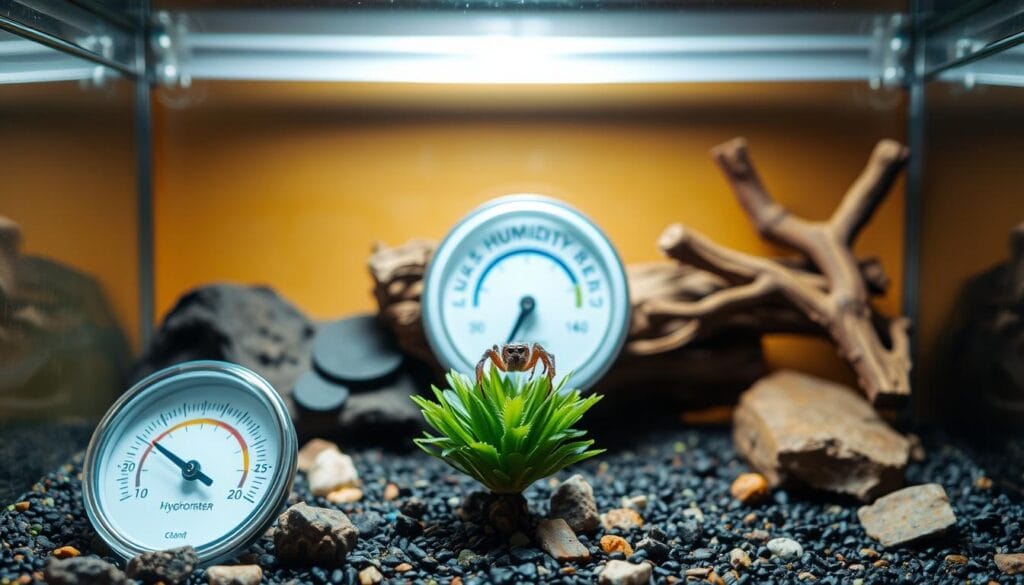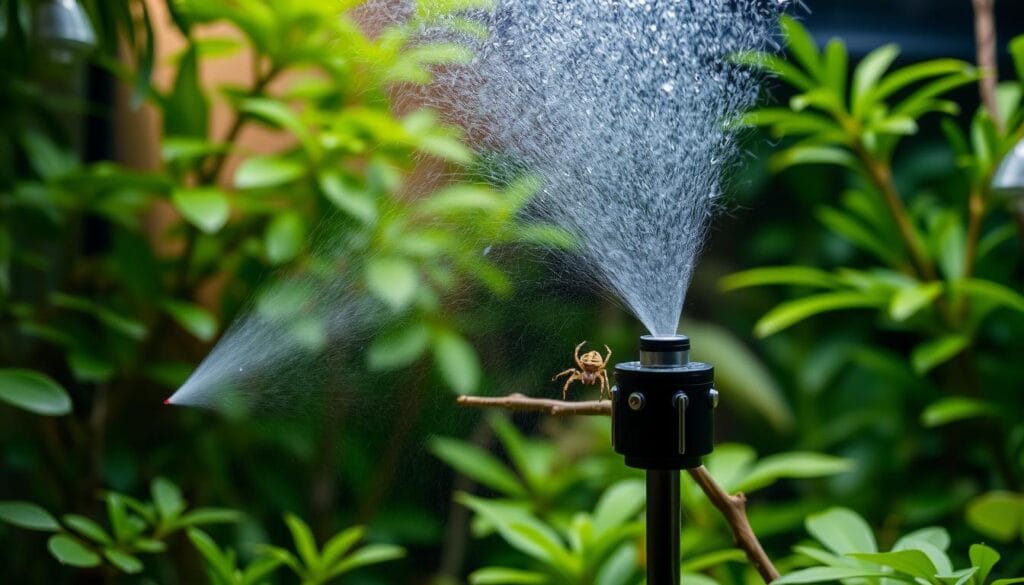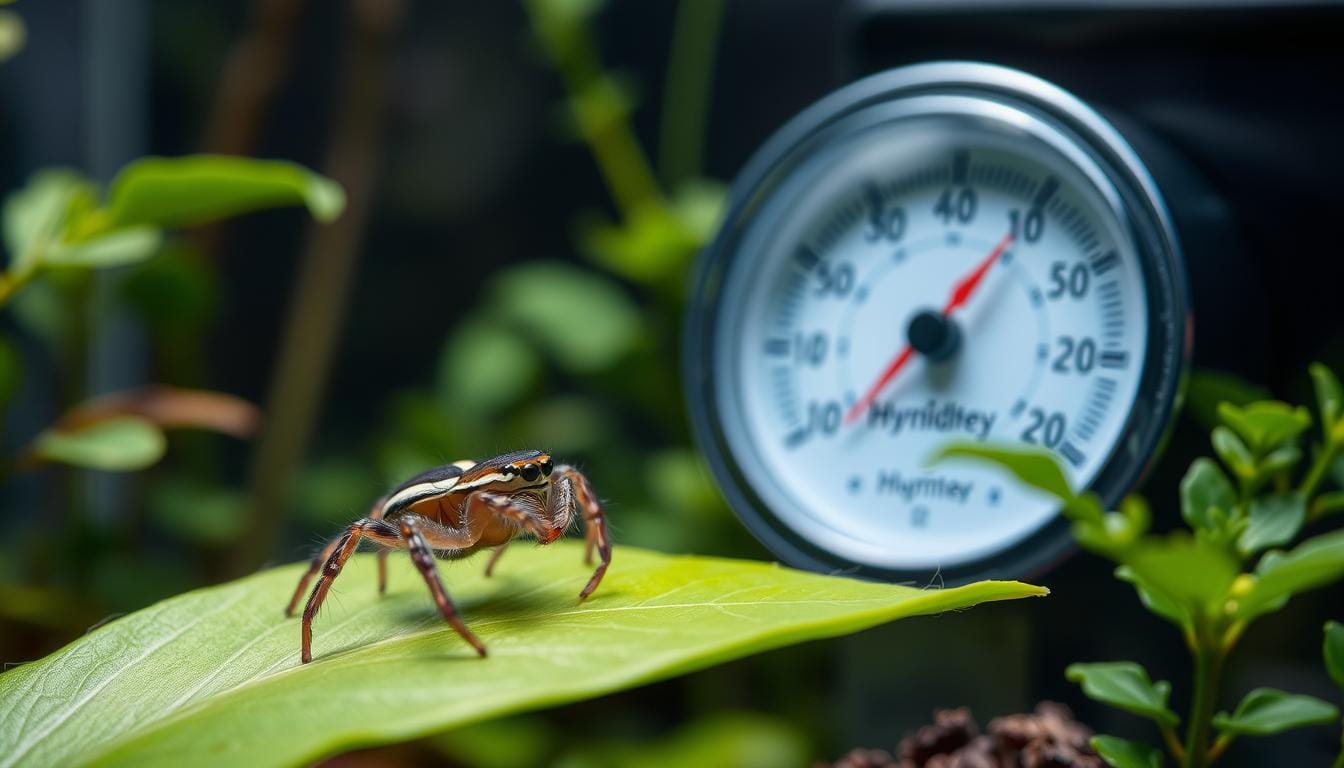If you love jumping spiders, you know how key it is to mimic their natural home. Keeping the optimal humidity levels is vital. It’s all about your spider’s health and happiness.
Creating the right environment can be tricky. But it’s crucial for your spider’s life. We’ll dive into why humidity matters and how to get it just right.
Table of Contents
Importance of Humidity for Jumping Spiders
To keep your jumping spiders healthy, it’s vital to replicate their natural humidity conditions. Humidity plays a crucial role in their overall health and well-being.
Why Humidity Matters
Jumping spiders thrive in environments with specific humidity levels. Maintaining the right humidity is crucial for their survival and vitality. In their natural habitat, these spiders are adapted to certain levels of moisture, and replicating this condition is essential for their care.
As noted by arachnid experts, “Humidity is a critical factor in the health and survival of jumping spiders.”
“The humidity level in a terrarium should mimic the spider’s natural environment to ensure their well-being.”
The Role of Humidity in Their Habitat
In their natural habitats, jumping spiders experience a range of humidity levels. Understanding and replicating these conditions is vital. The humidity in their habitat affects their metabolic processes and overall activity levels.
Effects of Low Humidity
Low humidity can lead to dehydration and stress in jumping spiders. It’s essential to monitor the humidity levels in their terrarium to prevent such issues. Signs of low humidity include lethargy and difficulty molting. Ensuring the right humidity level will help prevent these problems and keep your spiders healthy.
Ideal Humidity Levels for Jumping Spiders
Your jumping spider’s health and happiness depend on the right humidity in their terrarium. Like many arachnids, they need specific conditions to stay well.
Optimal Humidity Range
The best humidity for jumping spiders is between 60% to 80% relative humidity. This matches their natural habitats, giving them the moisture they need to thrive. Keeping humidity in this range is key for their health, molting, and activity.
Measuring Humidity in a Terrarium
To keep the terrarium’s humidity right, you need to measure it. A hygrometer is the best tool for this. It can be placed inside to show the humidity level, helping you adjust as needed.
Signs of Proper Humidity
Other than a hygrometer, there are signs of good humidity. If the humidity is correct, your spider will be active and healthy. Look for a well-kept web, regular molting, and lots of activity. If the humidity is off, your spider might show signs of stress or illness.
Knowing and keeping the right humidity is key to caring for your jumping spider. By making sure the humidity is just right, you create a healthy home for your pet.
How to Maintain Humidity in Terrariums
To keep your jumping spider happy, it’s key to know how to keep the humidity right. These spiders, known for their smarts and curiosity, need the right environment to thrive. For more on this, check out detailed articles.
Using a Humidifier
A humidifier is a great tool for keeping the terrarium humid. It releases a fine mist that keeps the air moist. Make sure to pick a humidifier that fits your terrarium’s size to avoid too much moisture.
Water Sources and Misting Techniques
Misting is another way to keep humidity up. Use a spray bottle to mist the terrarium lightly, without soaking the substrate. How often you mist depends on how well the terrarium breathes and the humidity around it. For more on misting and water needs, see later sections.
Substrate Selection for Moisture Retention
The type of substrate you choose is very important for keeping humidity right. Substrates like peat moss or coconut fiber hold moisture well. Picking the right one helps keep the terrarium’s humidity stable, making it comfy for your spider.
By using these methods, you can control humidity for jumping spiders and keep their terrarium healthy and lively.
Common Humidity-Related Issues
Knowing about humidity problems is important for your jumping spider’s health. Even with care, issues can still happen.
High Humidity Problems
Too much humidity can cause mold and harmful bacteria. This is bad for your spider.
- Mold and fungal growth
- Increased bacterial activity
- Reduced air quality
To avoid these problems, make sure the terrarium has good air flow. Also, keep an eye on humidity levels.
Low Humidity Problems
Low humidity can make your spider dehydrated. This can cause:
- Dry skin
- Difficulty molting
- Dehydration
Regular misting and using a humidifier can help keep humidity right.
Identifying Humidity-Related Health Issues
It’s important to know the signs of humidity problems in your spider. Look for lethargy, loss of appetite, or mold in the terrarium.
If you see these signs, change the humidity levels. If problems keep happening, talk to a vet.

Choosing the Right Substrate
Choosing the right substrate for your jumping spider’s terrarium is key for keeping the right humidity levels. The substrate you pick is very important. It helps make your spider’s home feel like its natural habitat, which is good for its health.
Types of Substrates for Humidity Control
There are many substrates, each with its own way of keeping moisture. This is important for understanding humidity needs in spider habitats. Here are some top picks:
- Coconut fiber, known for its excellent moisture retention properties.
- Sphagnum moss, which not only retains moisture but also provides a natural, humid microenvironment.
- Reptile bark, a cost-effective option that still offers good humidity control.
For more detailed guidance on setting up a jumping spider enclosure, you can refer to this comprehensive guide.
Mixing Substrates for Optimal Results
Mixing different substrates can help you get the humidity just right. For example, mixing coconut fiber with sphagnum moss can keep moisture better. It also gives your spider a varied home. Try different mixes to find what works best for your spider.
By picking and mixing substrates carefully, you can make a terrarium that feels like your spider’s natural home. This ensures it stays healthy and happy in its controlled environment.
Misting and Water Requirements
To keep your jumping spider happy, it’s key to know about misting and water needs. Keeping the right humidity is vital for its health. Misting helps a lot in keeping these levels right.
Best Practices for Misting
When misting, aim to match the spider’s natural humidity. Use a spray bottle with a fine nozzle for a light mist. Don’t mist too much, as it can cause mold and other problems.
Tips for Effective Misting:
- Mist in the morning so the terrarium can dry a bit by night.
- Use distilled or dechlorinated water to avoid harming your spider.
- Lightly spray walls and substrate, but avoid touching the spider.
Frequency of Misting
How often to mist depends on terrarium size, substrate, and humidity. Generally, misting once a day works for most setups.
| Terrarium Size | Substrate Type | Misting Frequency |
|---|---|---|
| Small (less than 5 gallons) | Dry substrates (e.g., sand) | Daily |
| Medium (5-10 gallons) | Moist substrates (e.g., sphagnum moss) | Every other day |
| Large (over 10 gallons) | Highly absorbent substrates | 2-3 times a week |
Importance of Clean Water
Using clean water is crucial for a healthy terrarium. Tap water can have chlorine and other harmful chemicals. So, use distilled or dechlorinated water for misting.
By following these tips and adjusting misting based on your terrarium’s needs, you can keep the right humidity. This will help your jumping spider stay healthy and happy.

Seasonal Changes and Humidity
As the seasons change, you might need to adjust the humidity in your jumping spider’s terrarium. This is key because these spiders are very sensitive to humidity changes. These changes can impact their health and how they behave.
Adjusting Humidity with Seasonal Changes
In summer, the air is drier, which can lower terrarium humidity. You might need to increase misting frequency or use a humidifier. This helps keep the ideal humidity for spider health.
In winter, the air is more humid. So, you might need to mist less or improve ventilation. This prevents too much moisture from building up.
It’s crucial to watch the terrarium’s humidity closely during seasonal changes. A hygrometer can help track these changes. This way, you can adjust humidity to keep it within the optimal humidity levels for your spider.
Effects of Seasonal Variation on Spider Behavior
Seasonal changes can also affect your jumping spider’s behavior. For example, some species may be more active at certain times. Knowing these changes helps you manage the terrarium better.
If your spider is more active in a certain season, it might need more precise humidity control. This supports its activity levels. Being aware of these changes helps create a stable and healthy environment for your spider all year round.
Monitoring Humidity Levels
For jumping spiders, the right humidity level is key to their health. It’s not just about comfort. You must create an environment that closely mimics their natural habitat.
Understanding Humidity Needs is vital. Jumping spiders have specific humidity requirements for their best health and activity. Regular checks help ensure your terrarium’s humidity is just right for your spider.
Tools for Humidity Monitoring
To monitor humidity effectively, you need the right tools. A hygrometer is essential for measuring terrarium humidity. You can find digital and analog hygrometers, so pick one that suits your needs and budget.
When choosing a hygrometer, look for accuracy and ease of use. Some models also measure temperature, which is important since it affects humidity in your spider’s environment.
Adjusting Conditions Based on Readings
With a hygrometer, you’ll need to adjust your terrarium based on readings. If humidity is low, increase misting or change your substrate to hold more moisture. If it’s too high, improve ventilation or mist less.
Making adjustments slowly and watching their effects on humidity is key. You might need to try a few things to get it just right. But it’s worth it for your spider’s health and happiness.
Regularly checking and adjusting humidity is a big step towards your spider’s well-being. This focus on detail will help you create a great environment that meets your spider’s needs.
Impact of Humidity on Spider Behavior
Humidity is key in how jumping spiders behave in captivity. Knowing how humidity affects your spider is important for their care.
How Humidity Affects Activity Levels
The humidity level greatly affects a jumping spider’s activity. In humid environments, spiders are more active. This is because moisture helps their breathing. On the other hand, low humidity can make them less active and dehydrated.
Keeping the right humidity is crucial for your spider’s health and activity. A study showed that spiders in the right humidity level hunt more and are more active. This is compared to those in drier conditions.
| Humidity Level | Activity Level | Health Impact |
|---|---|---|
| Optimal (60-80%) | High | Healthy, active |
| Low ( | Low | Dehydration risk |
| High (>80%) | Variable | Risk of fungal infections |
Breeding and Humidity
Humidity is also important for jumping spiders’ breeding. High humidity can trigger breeding. This is because it mimics the natural conditions of their wild habitats.
“In the wild, jumping spiders often breed during periods of high humidity, which signals the onset of favorable environmental conditions.”
For breeders, the right humidity is key for mating and healthy eggs and offspring. Different species need different humidity levels for breeding.
By controlling humidity, you can support your jumping spiders’ natural behavior and breeding. This makes for a more rewarding spider keeping experience.
DIY Solutions for Humidity Control
Keeping humidity right for jumping spiders doesn’t need to cost a lot. Simple DIY tricks can work wonders. With a few easy steps, you can keep the ideal humidity for spider health without spending a lot.
Creating a Simple Humidity Chamber
A humidity chamber can really help keep your spider’s environment just right. You can make one from a plastic container with a lid, some damp substrate, and small rocks or marbles. This keeps the spider away from the wet stuff. Drill holes in the lid for air to prevent too much moisture.
Put the container in your terrarium. It will act as a mini-humidity chamber. This is great during dry times or in cool spaces.
Using Natural Materials for Moisture Retention
Using natural materials that hold moisture is another smart DIY trick. Stuff like sphagnum moss or coconut fiber can be added to the substrate. They help keep humidity up and give your spider a natural home.
To get the most out of these materials, mist them lightly when you clean the terrarium. This keeps the substrate damp but not soggy. It makes an ideal environment for your jumping spider.
Adding these DIY ideas to your terrarium care can help your jumping spider stay healthy. It ensures they have the right humidity.
Conclusion: Balancing Humidity for Healthy Jumping Spiders
Keeping the right humidity is key for your jumping spider’s health. Knowing their humidity needs helps you create a great home for them.
Key Takeaways
To keep your jumping spider healthy, learn about their humidity needs. This means keeping the right humidity, using the best substrate, and misting correctly. Following these tips will help your spider thrive.
Tips for Spider Enthusiasts
If you love spiders, you want the best for your pet. Understanding their humidity needs and using the right methods will make your spider happy and healthy. With the right humidity, your spider will do well, and you’ll enjoy a fascinating pet.


Great write-up, I am regular visitor of one’s blog, maintain up the nice operate, and It’s going to be a regular visitor for a lengthy time.